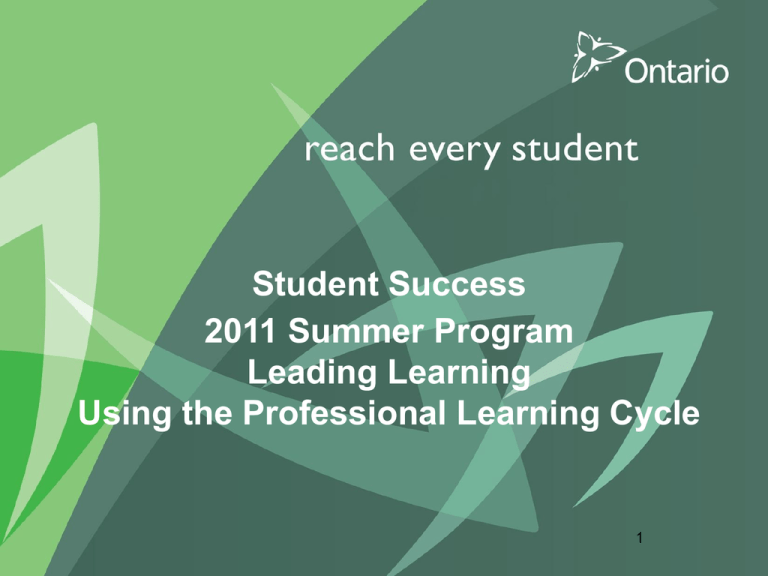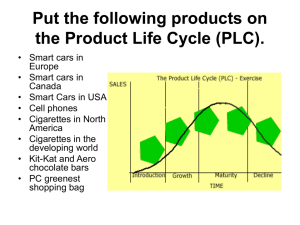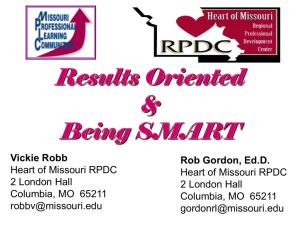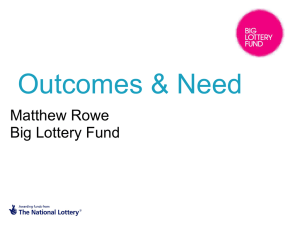AdministratorModule
advertisement

PUT TITLE HERE Student Success Student Success 2011Summer Summer Program 2011 Program Leading Learning Using the Professional Cycle NAME OF YOURLearning MODULE HERE 1 Session Agenda Minds On Administrator Profile Session Purpose Connection to the School Effectiveness Framework and the Ontario Leadership Framework Action Identify a SMART goal for a school improvement plan in response to student achievement data Identify the role of the Principal in organizing and engaging learning team members in a Learning Team Use the Professional Learning Cycle (PLC) to increase student achievement by providing a process for professional learning that is driven and focused by student learning needs. Consolidation Implications for School Improvement Planning Next Steps Implications for the role of the Principal within the context of the Ontario Leadership Framework 2 Administrator Profile Create a profile of your table group that includes: • Your role • Your experience working with learning teams • Learning preference • A year highlight • A strong professional interest 3 Session Purpose Identify the key role of the Principal in supporting School Improvement Planning by: •Leading Needs Assessment/SMART goal(s) •Creating Learning Teams within the context of the Ontario Leadership Framework •Supporting school-based Learning Teams as they use the Professional Learning Cycle •Aligning the work of Learning Teams with the school improvement planning process •Monitoring and Evaluating the school improvement planning process Provincial Context: Core Priorities High Levels of Student Achievement Reducing the Gaps in Student Achievement Increased Public Confidence in Our Publicly Funded Schools 5 3 School Effectiveness Framework 6 School Effectiveness Framework School and Classroom Leadership • 2.1 Collaborative instructional leadership builds capacity to strengthen and enhance teaching and learning • 2.2 Processes and practices are designed to deepen content knowledge and refine instructional to support student learning and achievement. • 2.4 Job-embedded and inquiry-based professional learning builds capacity, informs instructional practice and contributes to a culture of learning 7 Why Leadership? Leadership is a lever we are using to support large scale system improvement to enhance achievement and well-being for our 2 million students in 5000 schools 8 Why Leadership? After teaching, the second most influential factor on student learning is leadership (shared; formal and informal). Most-effective leadership dimension: promoting and participating in teacher learning and development 9 40 Self reflection on Instructional Leadership • What key practices, as an administrator, do I need to focus on to improve the quality of teaching and learning in my school? • Take 2 minutes to reflect individually and then share with an elbow partner. 10 Ontario Leadership Framework • Clarify successful practices • Robust foundation • Explicit connections between leaders’ influence and the quality of teaching and learning Setting Directions Building Relationships and Developing People Developing the Organization Leading the Instructional Program Securing Accountability 11 The OLF and 5 CLCs 12 Key Leadership Functions • Building Culture - Establishing networks (PLC s) of collaborative inquiry and planning where teachers, principals, and supervisory officers think, work, and learn together • Leading Change - Promoting and supporting professional practices that enable principals and teachers to lead implementation in their schools • Managing Complexity – Guiding systems and schools in developing, implementing and monitoring focused plans for student achievement, professional learning, and school improvement 13 Coherent Alignment – “The Skinny” The Principal Example Board (BIP) Literacy: Writing School (SIP) Literacy: Writing Gr. 9 & 10 Applied/Open Classroom (planning for teaching and learning) Professional Learning Cycle (collaborative inquiry) Literacy: Writing Gr. 9 Tech Ed and Visual Arts, Gr. 10 Computer Studies: Common Assessment area - Expression and Organization of Ideas (Achievement Chart) 15 School Improvement Plan for Student Achievement (SIPSA) Purpose includes to: • Develop specific student achievement goals on an annual basis through the analysis of school and classroom level data/evidence. • Improve achievement for each student in the school • Provide a tracking and monitoring plan for improving student achievement • Provide an evaluation of the school’s progress in meeting their SMART goals. 16 School Improvement Plan A school improvement plan for student achievement has many components including: • • • • • • Needs assessment and analysis SMART goals Professional learning/resources Targeted, evidence-based strategies/actions Monitoring Evaluation 17 School Improvement Plan Needs Assessment and Analysis Developing a SMART Goal School level data Develop SMART goal 18 Drilling Down: Questions to Consider • What data should be considered, eg. board and school pass rates, learning skills and work habits? • What are the courses students are failing, eg., grade level, subject discipline, level of study? 19 Examine the Data You will be working in triads to review and analyze the data strips. There are guided questions to direct your analysis. 20 Your Professional Judgement 2009/10 - Pass Rate - Applied Math - Grade 10 2008/09 - Pass Rate - Applied Math - Grade 10 2007/08 - Pass Rate - Applied Math - Grade 10 2009/10 - Pass Rate - Applied Math - Grade 9 2008/09 - Pass Rate - Applied Math - Grade 9 2007/08 - Pass Rate - Applied Math - Grade 9 2009/10 - Pass Rate - Applied English - Grade 10 2008/09 - Pass Rate - Applied English - Grade 10 2007/08 - Pass Rate - Applied English - Grade 10 2009/10 - Pass Rate - Applied English - Grade 9 2008/09 - Pass Rate - Applied English - Grade 9 2007/08 - Pass Rate - Applied English - Grade 9 C 2007/08 2008/09 2009/10 2007/08 2008/09 2009/10 2007/08 2008/09 2009/10 2007/08 2008/09 2009/10 Pass Pass Pass Pass Pass Pass Pass Pass Pass Pass Pass Pass Rate Rate Rate Rate Rate Rate Rate Rate Rate Rate Rate Rate Applied Applied Applied Applied Applied Applied Applied Applied Applied Applied Applied Applied English English English English English English Math Math Math Math Math Math Grade 9 Grade 9 Grade 9 Grade 10 Grade 10 Grade 10 Grade 9 Grade 9 Grade 9 Grade 10 Grade 10 Grade 10 84.8% 85.8% 86.5% 82.9% 83.8% 84.8% 81.5% 83.1% 84.0% 78.5% 79.7% 80.2% 84.9% 91.2% 79.4% 88.0% 86.9% 76.3% 86.7% 81.1% 79.6% 76.3% 80.0% 76.2% 0.1% 5.4% -7.1% 5.1% 3.1% -8.5% 5.2% -2.0% -4.5% -2.2% 0.3% -4.0% What is a SMART Goal? S =Specific – addresses subject area including the grade and level of instruction M =Measurable – includes pass rates and includes baseline data A =Achievable – provides ambitious yet attainable outcomes in the timelines provided R =Results-based – focuses on increasing student pass rates T =Time – specifies time frame 22 Activity # 4 Developing a SMART Goal Using the data strip provided: • Develop a SMART goal with your table partners As a group: • Discuss why it is a SMART goal based on the 5 components using the rubric provided School Improvement Plan A school improvement plan for student achievement has many components including: • • • • • • Needs assessment and analysis SMART goals Professional learning/resources Targeted, evidence-based strategies/actions Monitoring Evaluation 24 Professional Learning Cycle Notes Organizer 25 Professional Learning Cycle The goal of the Professional Learning Cycle Strategy is to increase student engagement and achievement by providing a process for professional learning that is driven and focused by student learning needs. 26 The Professional Learning Cycle Professional learning is driven and focused by student needs. • Begins by examining evidence of student achievement and engagement to determine an area of student need • Focuses educator learning on strategies required to address the identified need • Emphasizes implementation informed by observation of student work • Stresses professional dialogue with colleagues • Requires a collaborative analysis of data to determine the extent to which the identified area of student need has been met 27 16 A Professional Learning Cycle 28 From SMART Goal to Creating Professional Learning Teams Question to consider • How would you establish readiness for school learning teams and the Professional Learning Cycle Discuss as a group. Video: Building Capacity Learning Teams Professional learning team meetings have one primary purpose: improved teaching and learning in an area of identified student need. The aim is… to provide a way for teachers to become increasingly accomplished instructors for the Source: ultimate benefit of students … The Evolution of a Professional Learning not (simply) to develop Team, Tools for Schools professional learning teams. (NSDC), Nov./ Dec. 2008 30 Guided Viewing: Principal’s Role in Establishing and Supporting Learning Teams • What do you need to consider when establishing learning teams (e.g., multi-disciplinary, same grade/subject, learning team/cycle experience)? • What do you need to consider when coordinating the various learning teams (e.g., facilitators, common preps)? • What is the role of the principal in supporting learning teams using the Professional Learning Cycle? Video clip – Leadership and Facilitation 31 Learning Teams Identifying a strategic / targeted learning need School level data Class level data Student Success Leader and Principal Professional Learning Team 32 Focusing on Data and Evidence Adapted from The EvidenceBased School, K. Hume, 2009. 1. Analysis: asking questions, finding patterns and trends, comparing 2. Interpretation: making sense of evidence, seeking evidence that supports initial interpretation 3. Data/evidence source (e.g., assignment marks in markbook, student work) 4. Decisions and Actions 33 Connecting the SMART goal to Classroom Instruction Key Questions for Learning Teams: • What are the learning needs of our students? • How does the school SMART goal sharpen the focus on student learning needs? • What do we need to learn in order to address student learning needs? 34 Learning Teams Developing a strategic / targeted SMART Goal S = Specific – addresses an area of student knowledge and skills that need significant improvement for a target group of students M = Measurable – includes levels and includes baseline data, as well as, diagnostic and assessment of learning data on student knowledge and skill development A = Achievable – provides ambitious yet attainable outcomes in the timelines provided R = Results-based – focuses on increasing students’ knowledge and skills and student improvement as measured by level T = Time – specifies time frame within the learning cycle Professional Learning Team Guided Viewing: The PLAN Phase What data sources are considered? What are teachers learning from the data? What are the next steps being considered: • For student learning? • For educator learning? Discuss as a group. Video – Plan Phase Guided Viewing: Impact of the Professional Learning Cycle on Teacher Practice Question to consider • What impact has the Professional Learning Cycle process had on teachers? • What is the major difference seen in instructional planning and practice? Discuss as a group. Video - Introduction 37 School Improvement Plan The School Improvement Plan for Student Achievement has many components including: • • • • • • Needs assessment and analysis SMART goals Professional learning/resources Targeted, evidence-based strategies/actions Monitoring Evaluation 38 School Improvement Planning Next Steps Questions to Consider: • What is the educator learning for this team and what were the next steps identified by them? • How does the work of learning teams, using the Professional Learning Cycle, inform the next steps for school improvement planning? Video clip – Reflect Phase – English Learning Team 39 30 Consolidation With respect to the work of school-based Learning Teams what are the connections between the Principal’s influence and the quality of teaching and learning? Use the Ontario Leadership Framework, leadership practices and competencies to guide your discussion. Setting Directions Building Relationships and Developing People Developing the Organization Leading the Instructional Program Securing Accountability 40 30 Reflect and capture your insight Reflect Through your review and sharing, to what did you react strongly? • Insight: ‘ah ha’ moment • Concern: “whoa, that is a red flag” • Affirmation: “ya, right on!” Prepare to share 41







